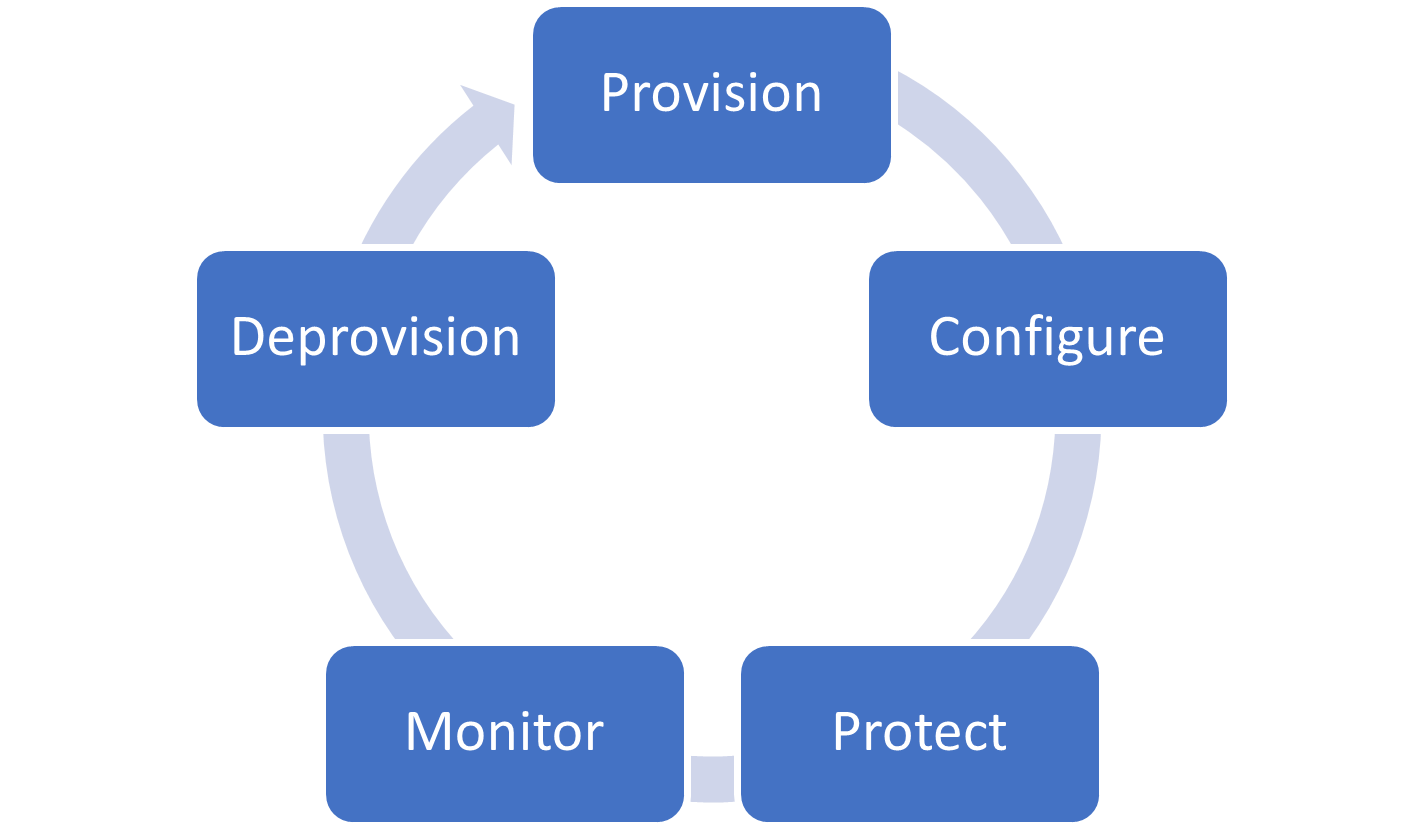Životní cyklus cloudových počítačů
Windows 365 koordinuje a spravuje životní cyklus všech cloudových počítačů. Vzhledem k tomu, že cloudové počítače existují jenom v cloudu, je správa životního cyklu cloudových počítačů jednodušší než správa fyzických životních cyklů zařízení s Windows. Cloudové počítače nikdy neopustí možnosti správy a zabezpečení, které cloud poskytuje.
Životní cyklus cloudových počítačů má pět fází:

Poskytnutí
Windows 365 poskytuje optimalizované prostředí pro nasazení cloudových počítačů. Prostředí pro správu pro nastavení nasazení je integrované do centra pro správu Microsoft Intune. Cloudové počítače jsou zřízené ve službě Windows 365, připojené k Azure, připojené k vašemu Microsoft Entra ID a zaregistrované do Microsoft Intune.
Přiřazením licence Windows 365 uživateli a jeho přidáním do skupiny, na kterou cílí zásady zřizování, aktivujete automatické zřizování cloudového počítače uživatele.
Každý Cloud PC se vytvoří pomocí image operačního systému. Windows 365 obsahuje galerii výchozích imagí, které poskytují prostředí vzdáleného připojení optimalizované pro Windows i Microsoft 365. Můžete také nahrát vlastní image a Windows 365 provede některé optimalizace za vás.
Windows 365 má také monitorovací infrastrukturu a syntetické zřizovací testy integrované do síťových připojení Azure. Tyto testy se spouštějí pravidelně a testují sítě a další požadavky. Tyto testy pomáhají minimalizovat selhání zřizování kvůli problémům s prostředím a pomáhají vám tyto problémy rychleji vyřešit.
Konfigurace
Cloudové počítače musí být nakonfigurované a zabezpečené stejně jako jakýkoli jiný koncový bod ve vašem prostředí. Aby byla tato konfigurace bezproblémová, každá Windows 365 Cloud PC je v rámci zřizování:
Po připojení se cloudové počítače zaregistrují do Microsoft Intune. Tato registrace znamená, že každý cloudový počítač je okamžitě připravený na Microsoft Entra podmíněný přístup a správu prostřednictvím Microsoft Intune, včetně spolusprávy v případě potřeby.
Microsoft Intune pomocí zásad dodržování předpisů vám pomůže ověřit, jestli jsou cloudové počítače kompatibilní. Windows 365 také poskytuje optimalizované standardní hodnoty zabezpečení pro cloudové počítače. Tento volitelný směrný plán vám pomůže zajistit, aby cloudové počítače byly bezpečně nakonfigurované s minimální režií. Tyto standardní hodnoty byly optimalizovány tak, aby se zajistilo, že nebude mít vliv na vzdálené připojení.
Ochrana
Windows 365 se integruje se zbytkem Microsoftu 365 a zajišťuje tak zabezpečení cloudových počítačů. Integraci Microsoft Intune s Microsoft Defender for Endpoint můžete použít k ochraně cloudových počítačů od okamžiku jejich zřízení. Tato ochrana zahrnuje použití možností detekce koncových bodů a odpovědí Microsoft Defender for Endpoint k určení rizika zařízení.
Windows 365 lze také chránit pomocí Microsoft Entra podmíněného přístupu. Tato ochrana zahrnuje volitelné vyloučení samotného Windows 365 ze zásad dodržování předpisů zařízením, aby se zajistilo, že koncoví uživatelé budou mít přístup ke svým cloudovým počítačům z libovolného zařízení. Stále můžete používat vícefaktorové ověřování, riziko přihlášení a další ovládací prvky k zajištění bezpečného ověření uživatele.
Windows 365 používá možnost automatické kontroly služba Windows Update k instalaci nejnovějších aktualizací pro zvýšení kvality. Aby se zajistilo, že se aktualizace nainstalují okamžitě, měl by se koncový uživatel co nejdříve přihlásit k nově zřízenému počítači Cloud PC.
Můžete také zakázat přesměrování schránky a jednotek, abyste zajistili základní ochranu před únikem informací. Zakázání zabrání uživatelům v:
- Kopírování a vkládání informací z cloudových počítačů do jiných nespravovaných umístění
- Ukládání souborů do osobních zařízení z cloudových počítačů
Sledování
Klíčovým požadavkem cloudových počítačů je zajistit, aby virtuální hardware odpovídal potřebám koncového uživatele. Windows 365 se integruje s analýzou koncového bodu ve skóre produktivity Microsoftu. Analýza koncových bodů poskytuje měření výpočetního a paměťového zatížení na cloudových počítačích. Potom můžete pomocí Windows 365 změnit velikost cloudových počítačů tak, aby odpovídaly požadavkům uživatelů a jejich aplikací. Tato akce změny velikosti se zobrazí v Microsoft Intune spolu s dalšími akcemi zařízení, aby se zajistilo bezproblémové prostředí mezi cloudovými počítači a dalšími koncovými body.
Nápravu v analýze koncových bodů můžete použít také ke zlepšení monitorování a nápravy v cloudových počítačích. Náprava umožňuje rozšířit integrované optimalizace Microsoftu 365, které Windows 365 poskytují, včetně optimalizace pro heterogenní IT prostředí.
Zrušení zřízení
Existuje několik způsobů, jak bezpečně odebrat přístup uživatele ke cloudovým počítačům. Pokud odeberete licenci uživatele nebo zásady cíleného zřizování, přesune se cloudový počítač do sedmidenního období odkladu. Tato období odkladu umožňuje chyby a obnovení, aniž by to mělo vliv na uživatele. Pokud chcete přístup zablokovat okamžitě, zakažte uživatelský účet v místní Active Directory a odvoláte obnovovací tokeny uživatele v Microsoft Entra ID.
Po uplynutí poskytnuté lhůty Windows 365 úplně zruší zřízení počítače Cloud PC a jeho úložiště. Cloudové počítače se šifrují pomocí šifrování na straně serveru ve službě Azure Disk Storage (klíče spravované platformou), aby se zařízení bezpečně zrušovala.